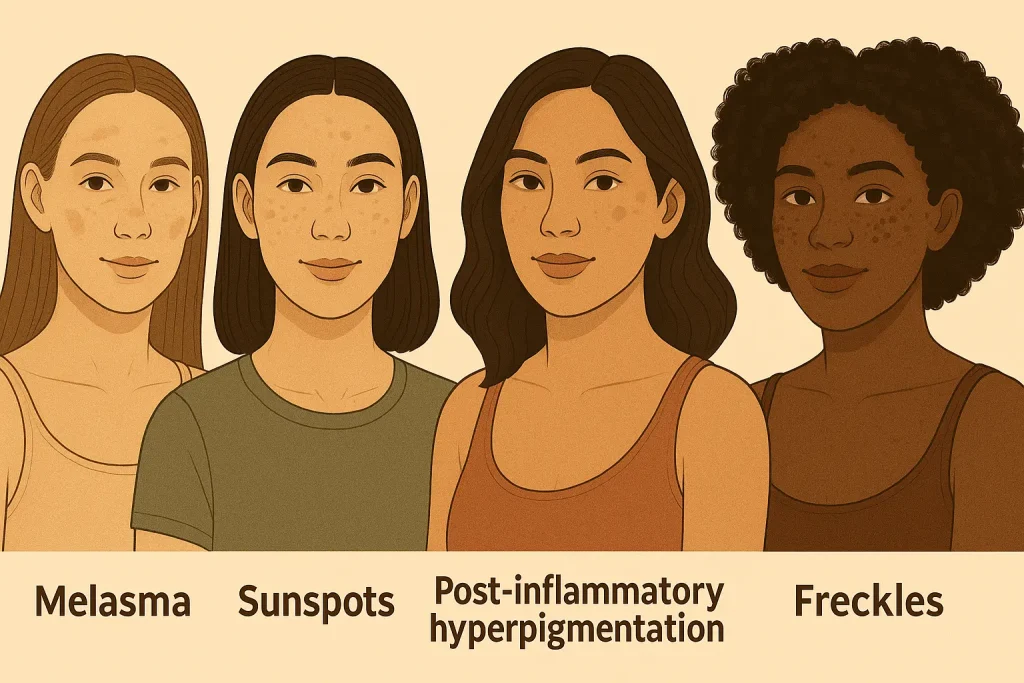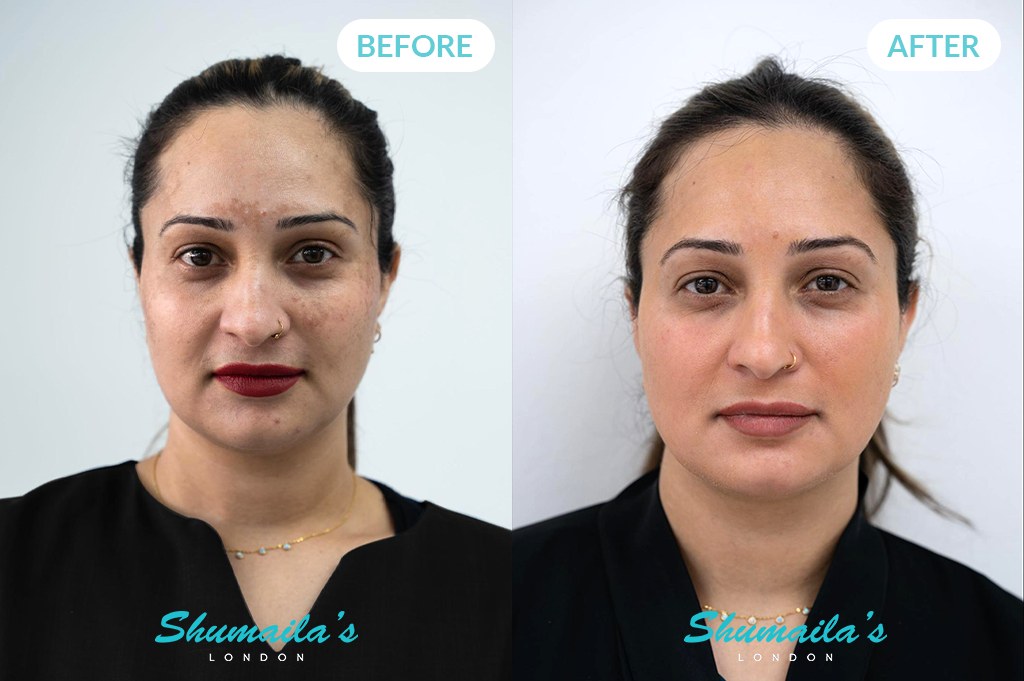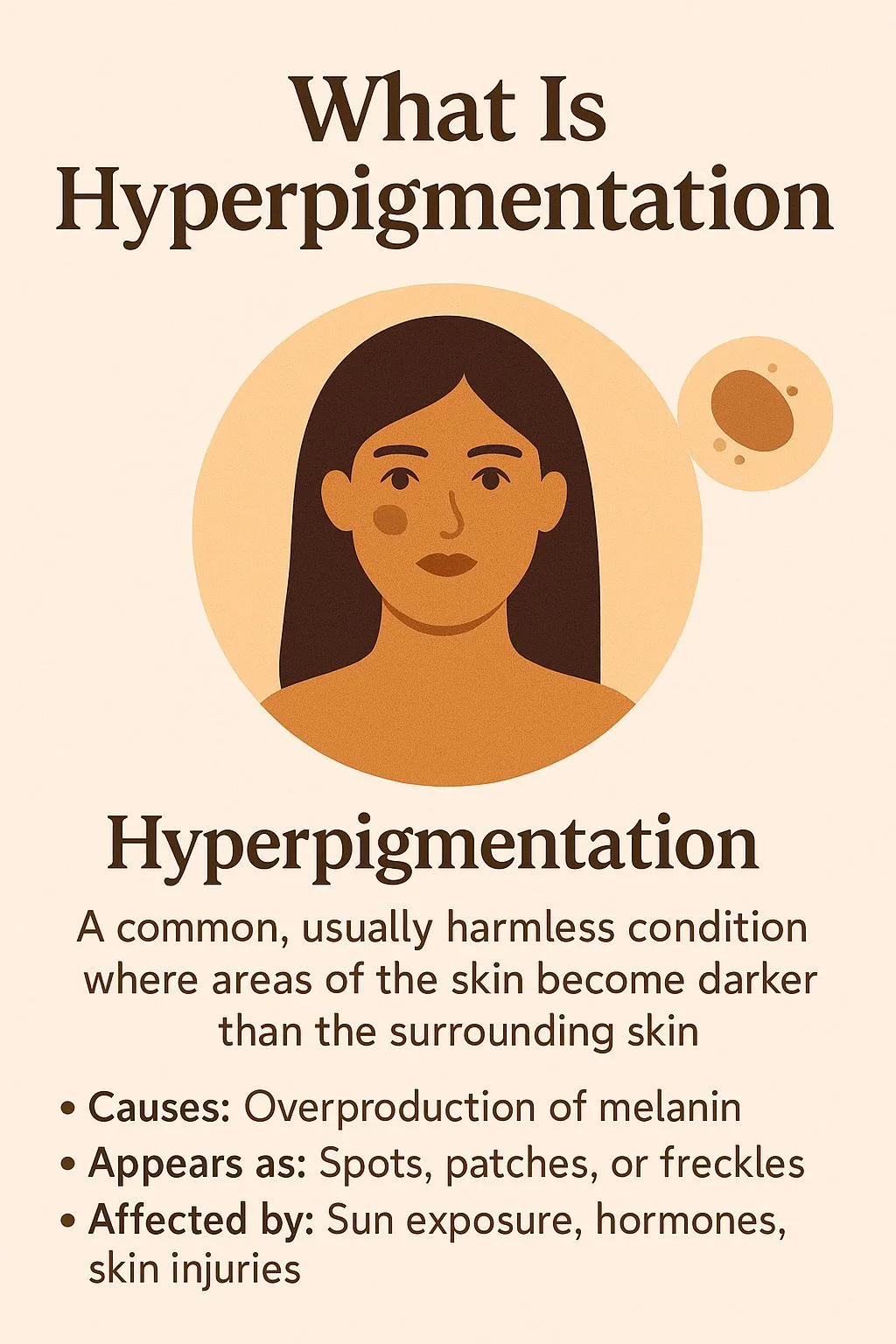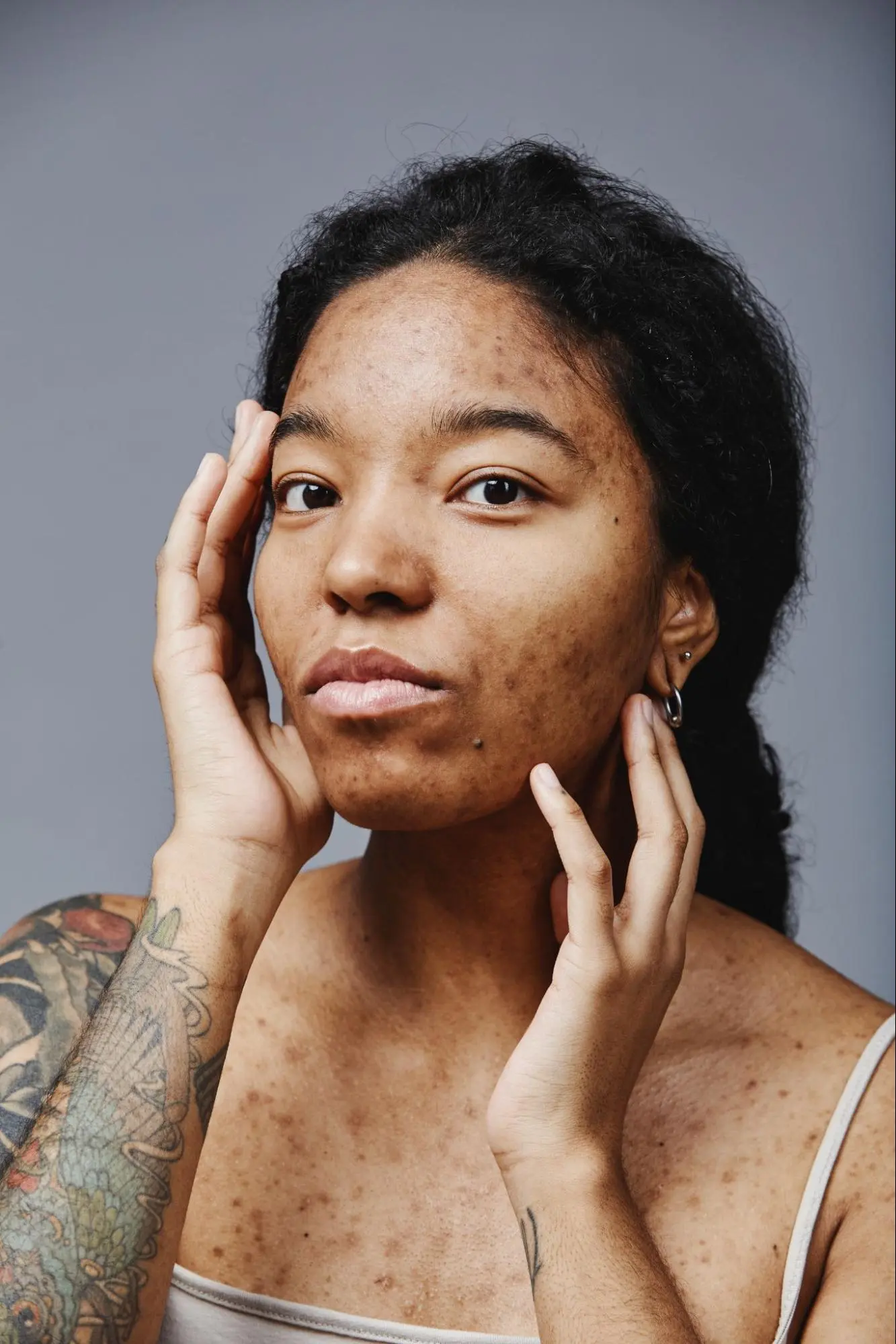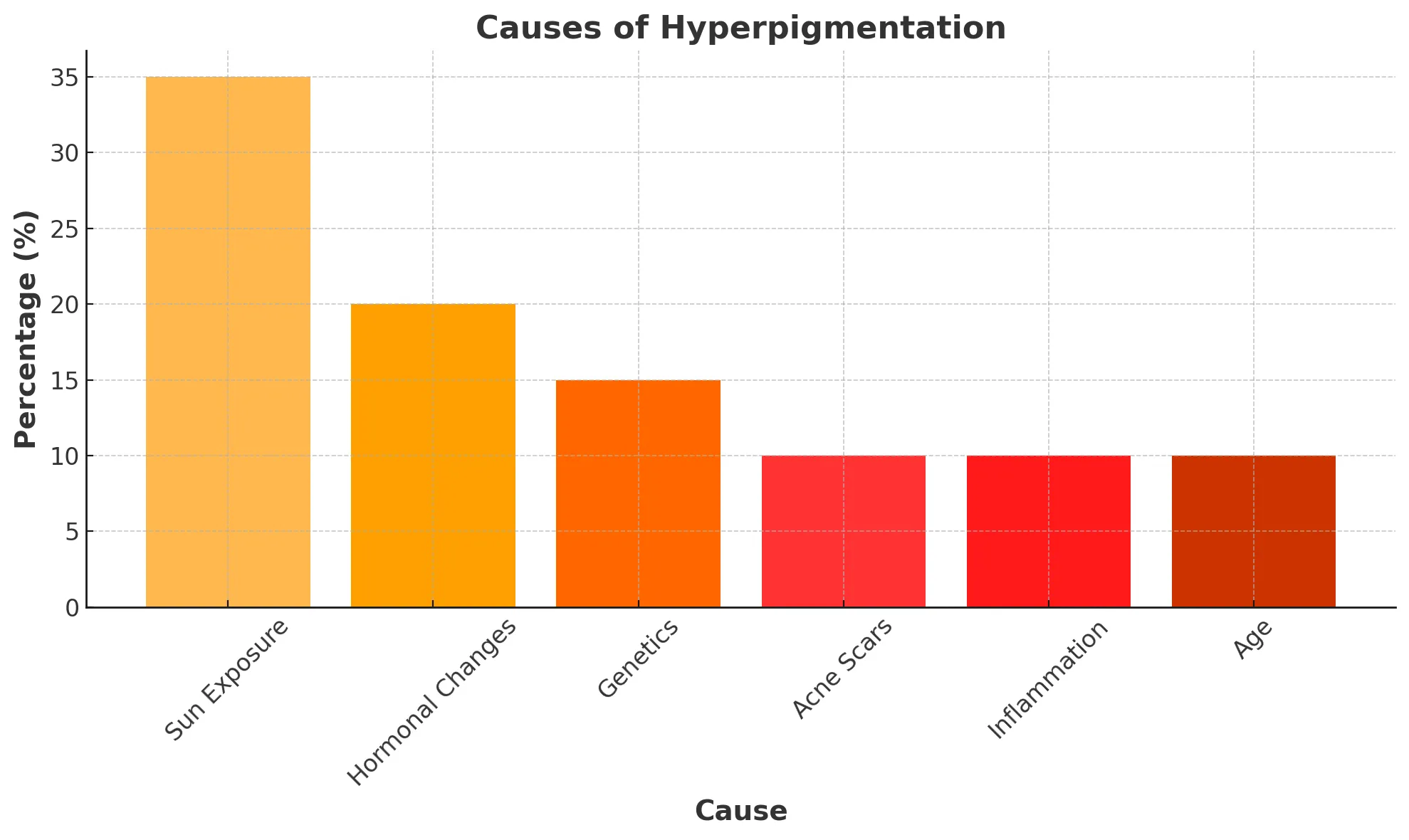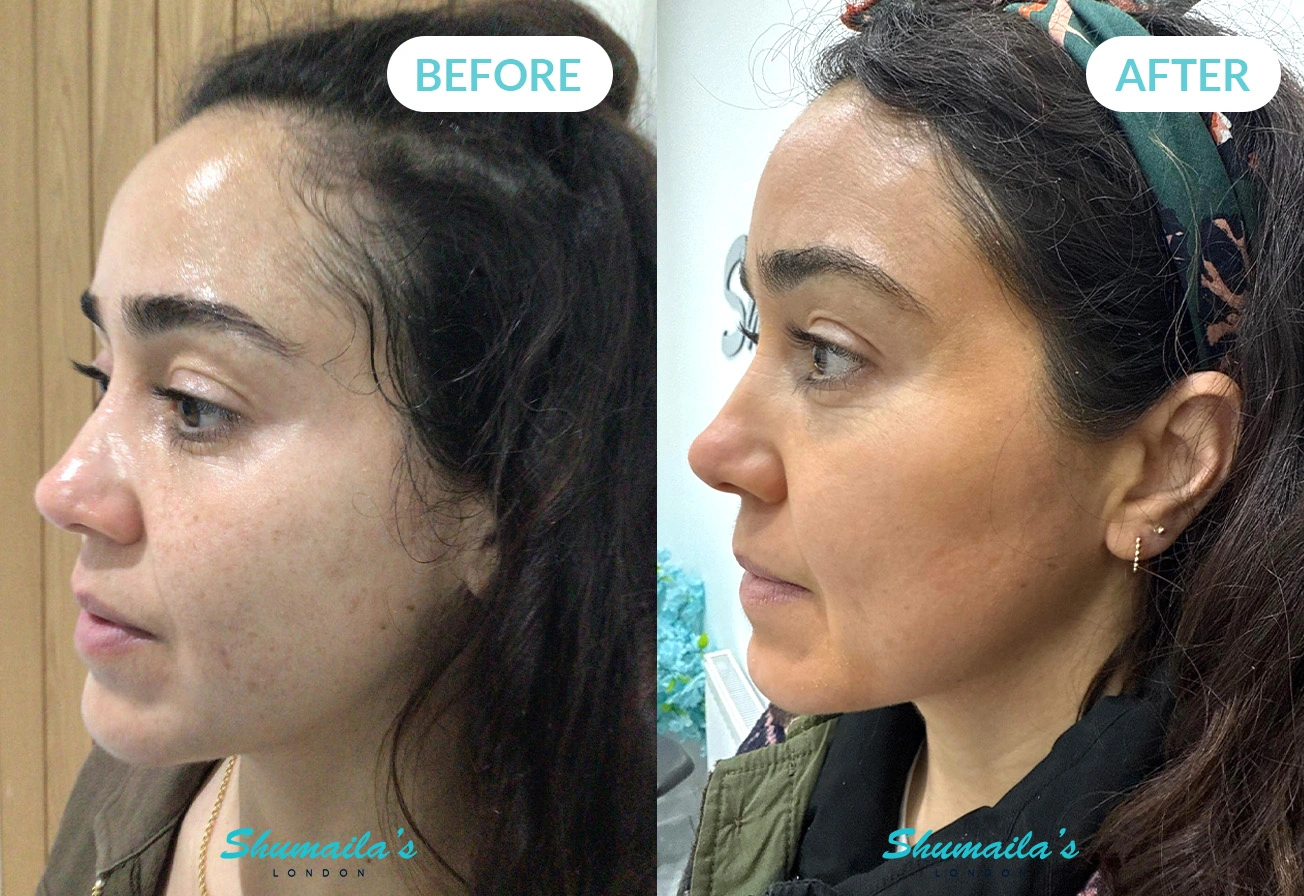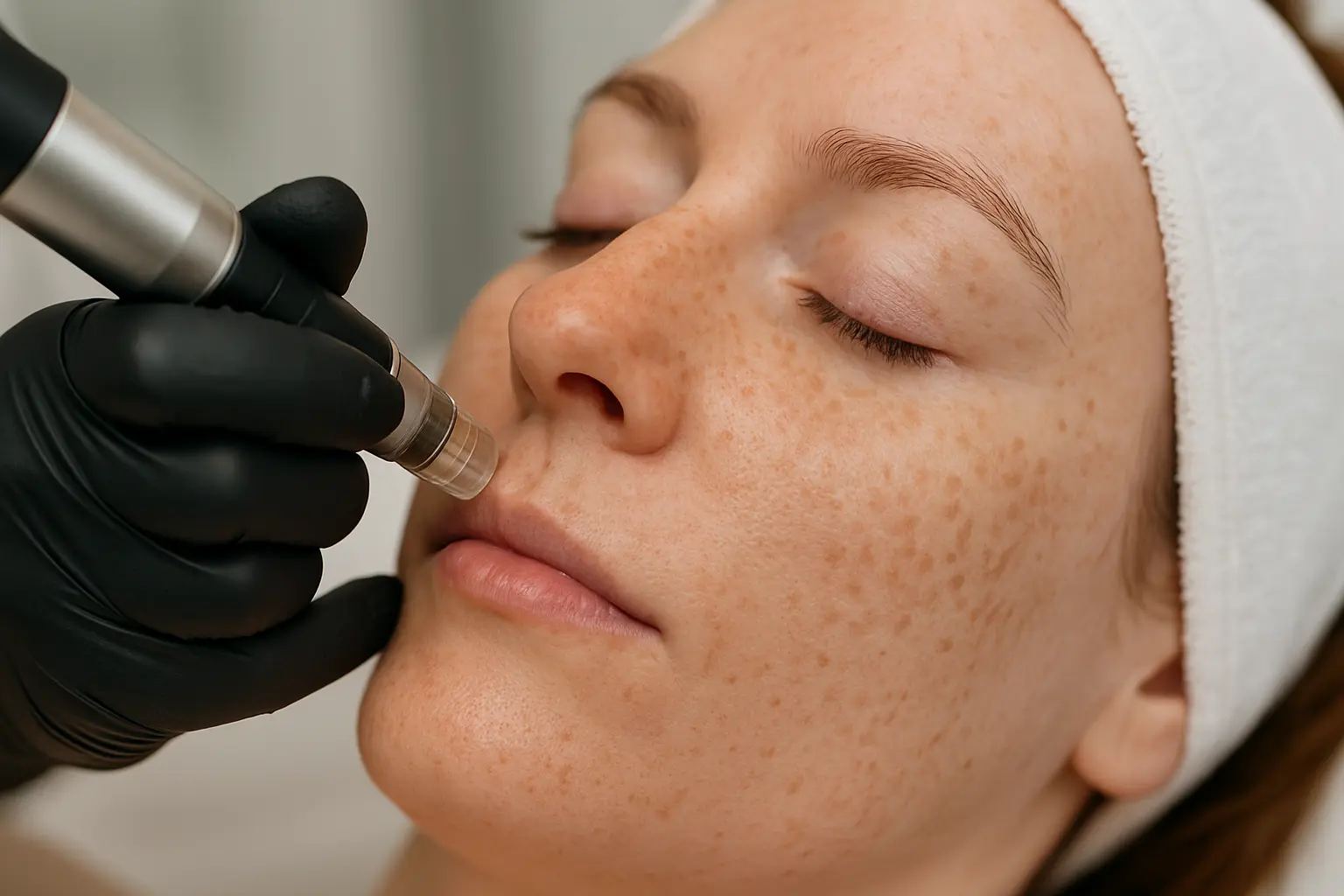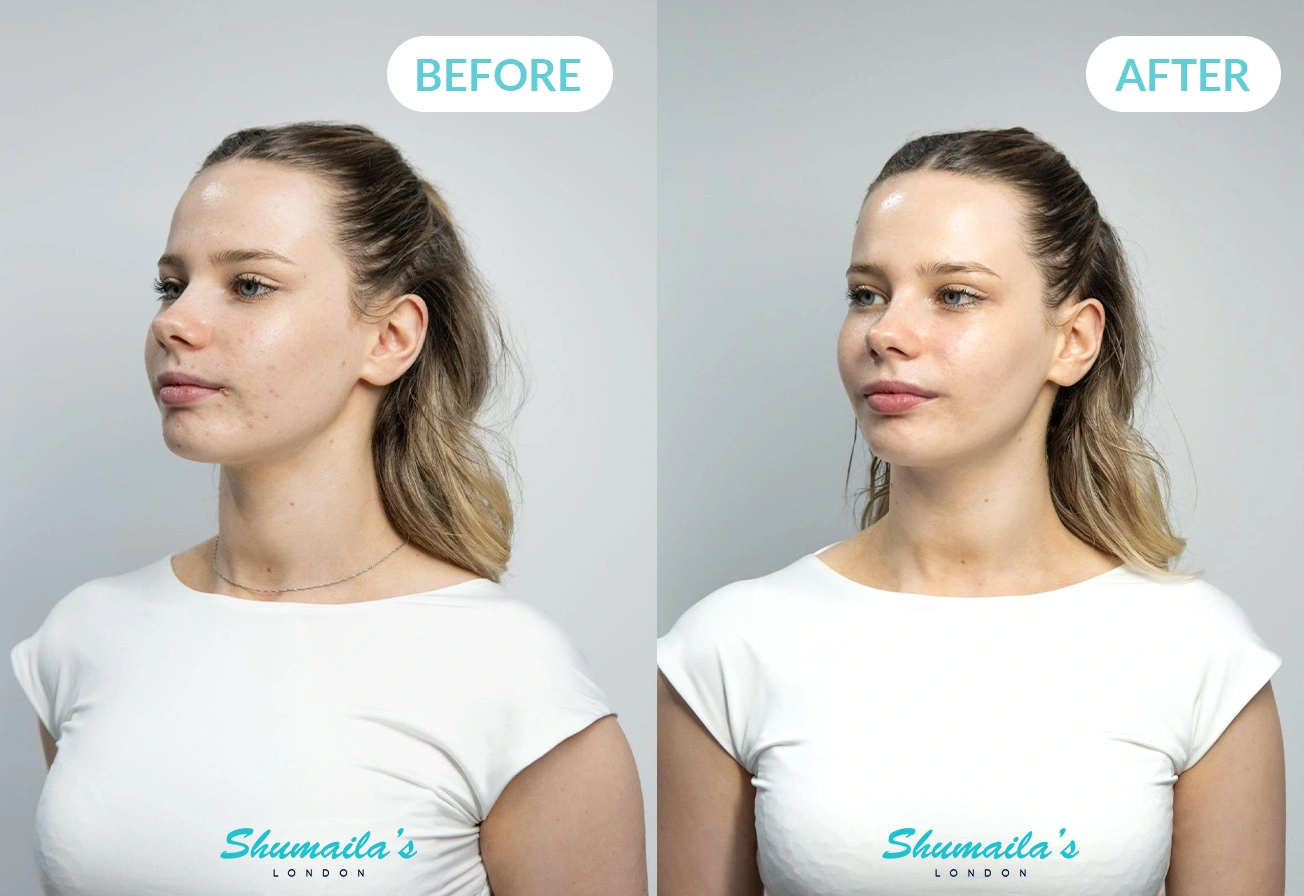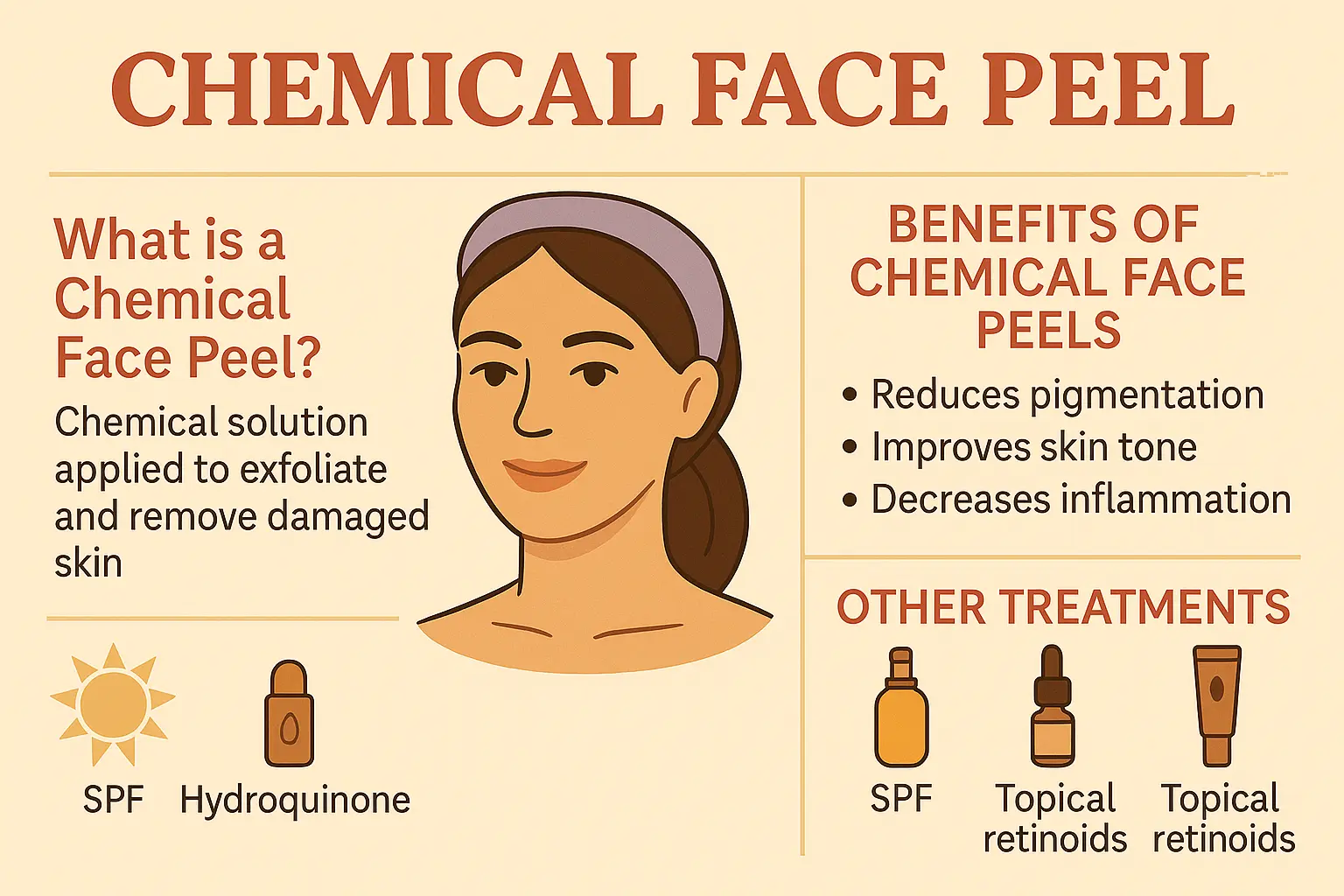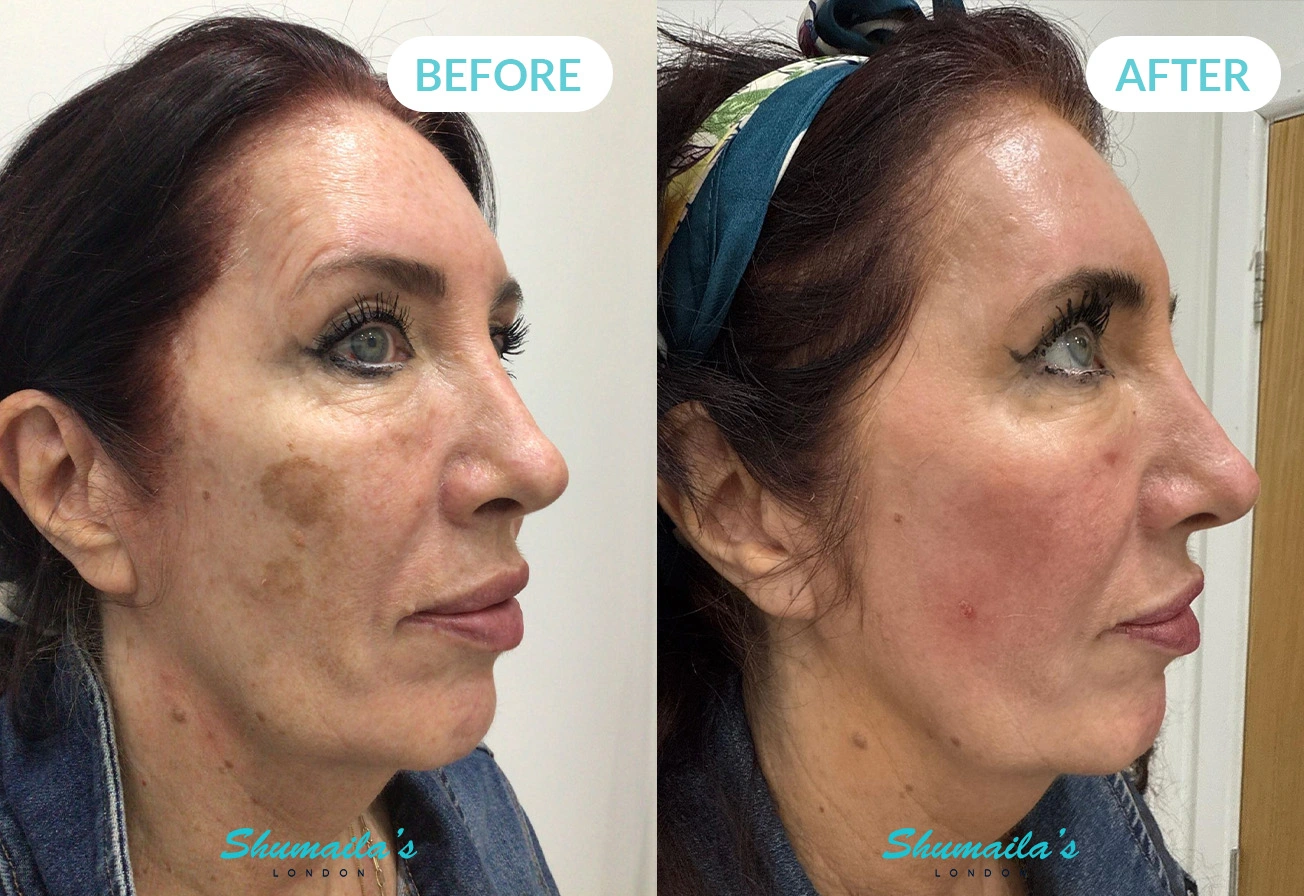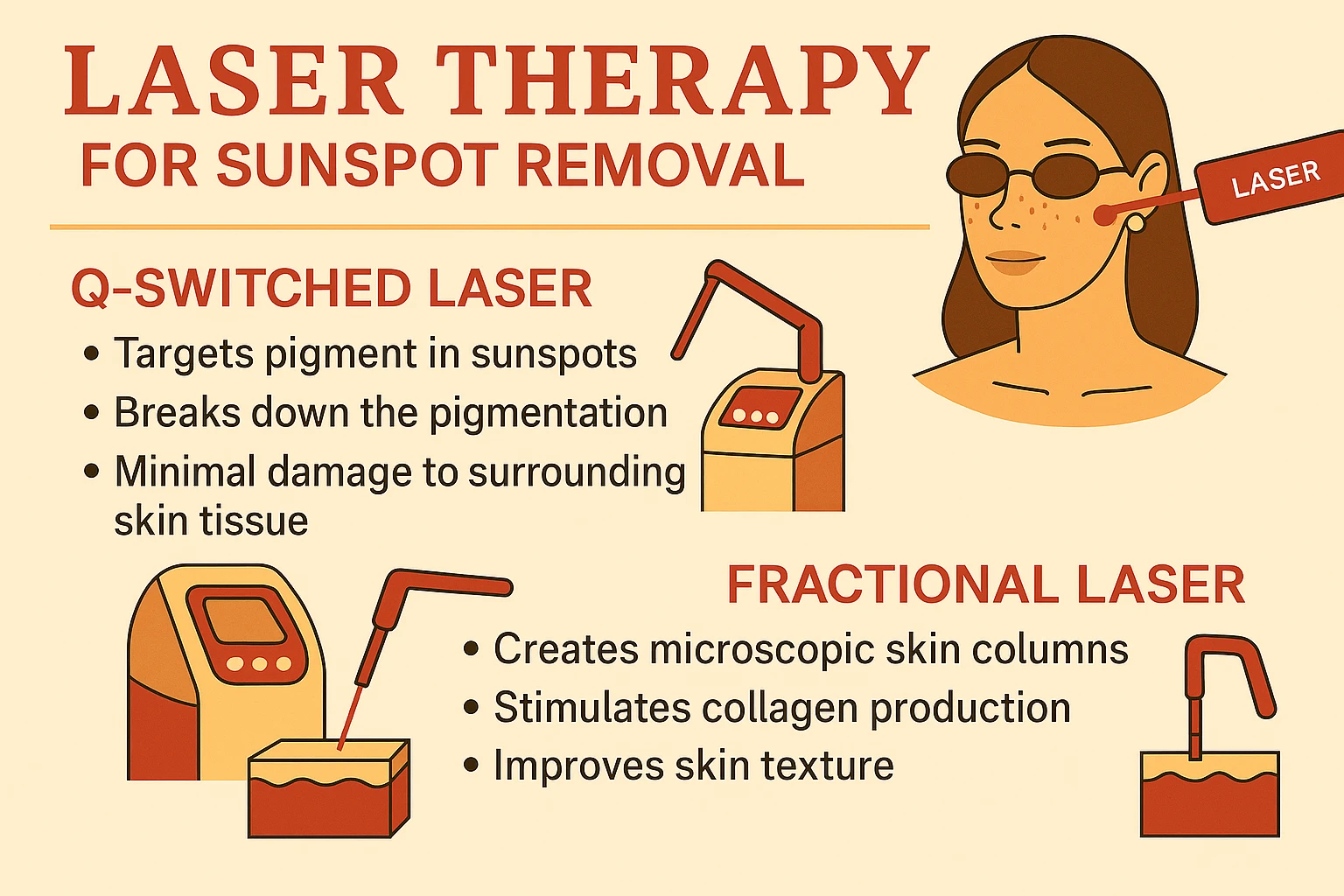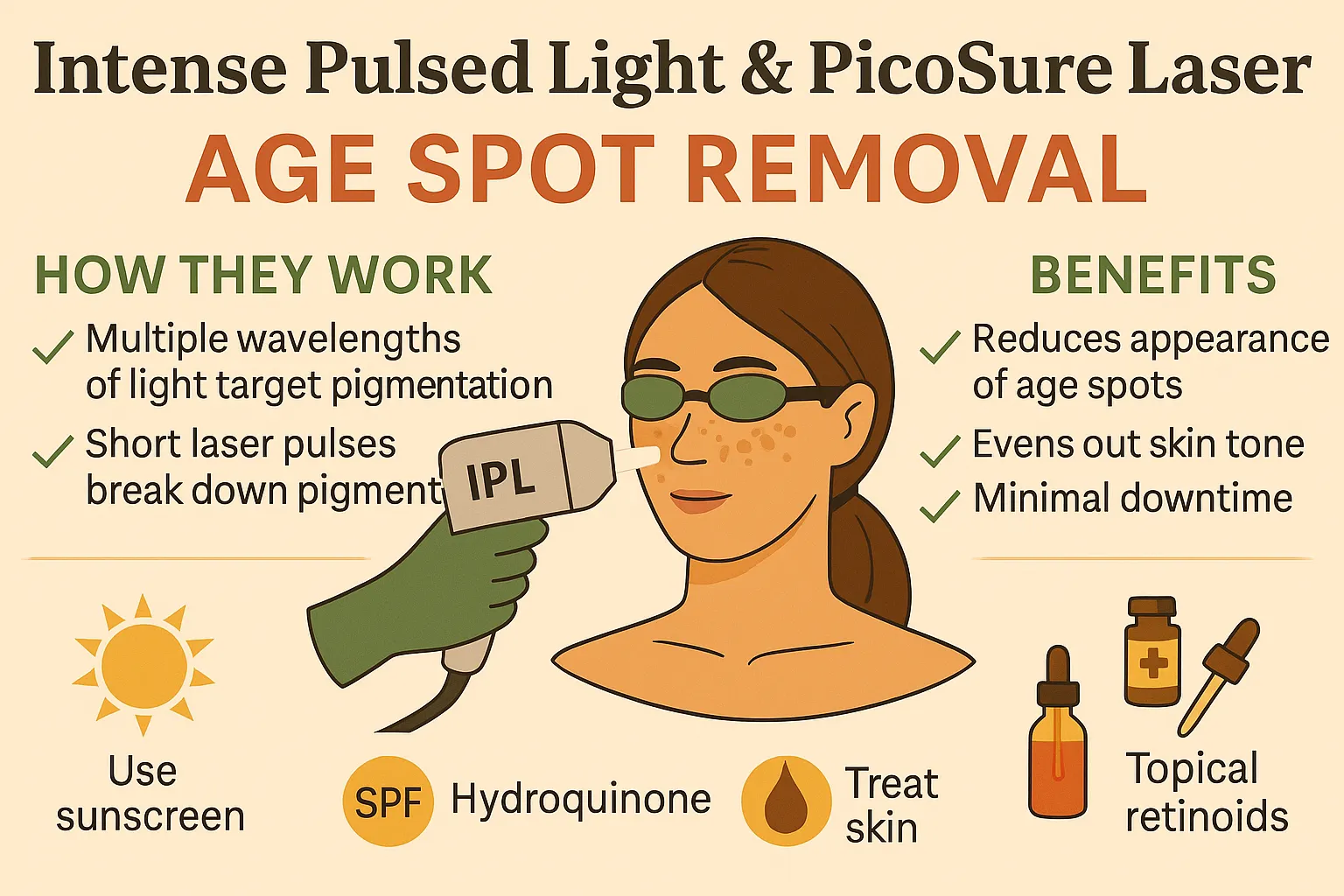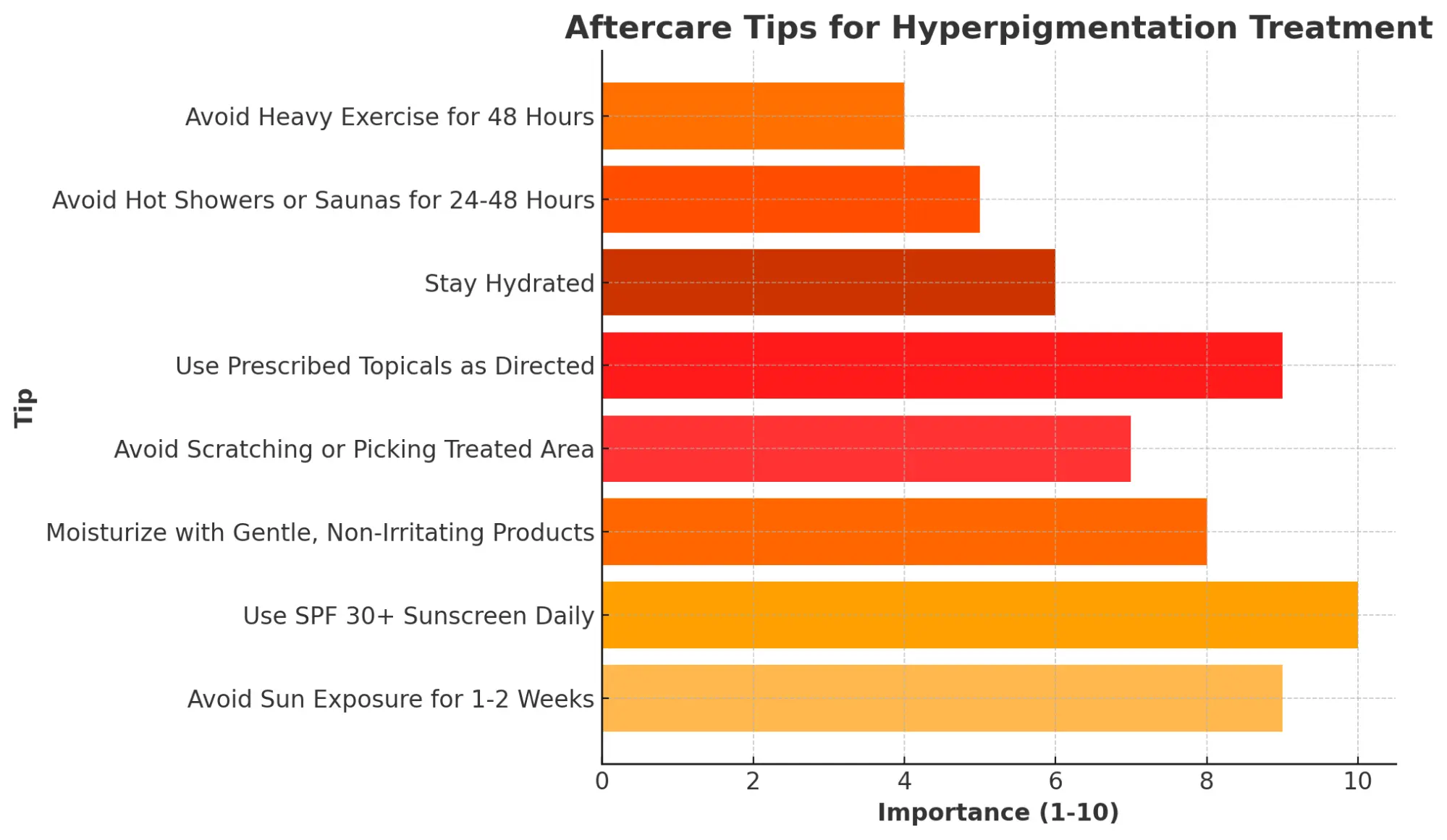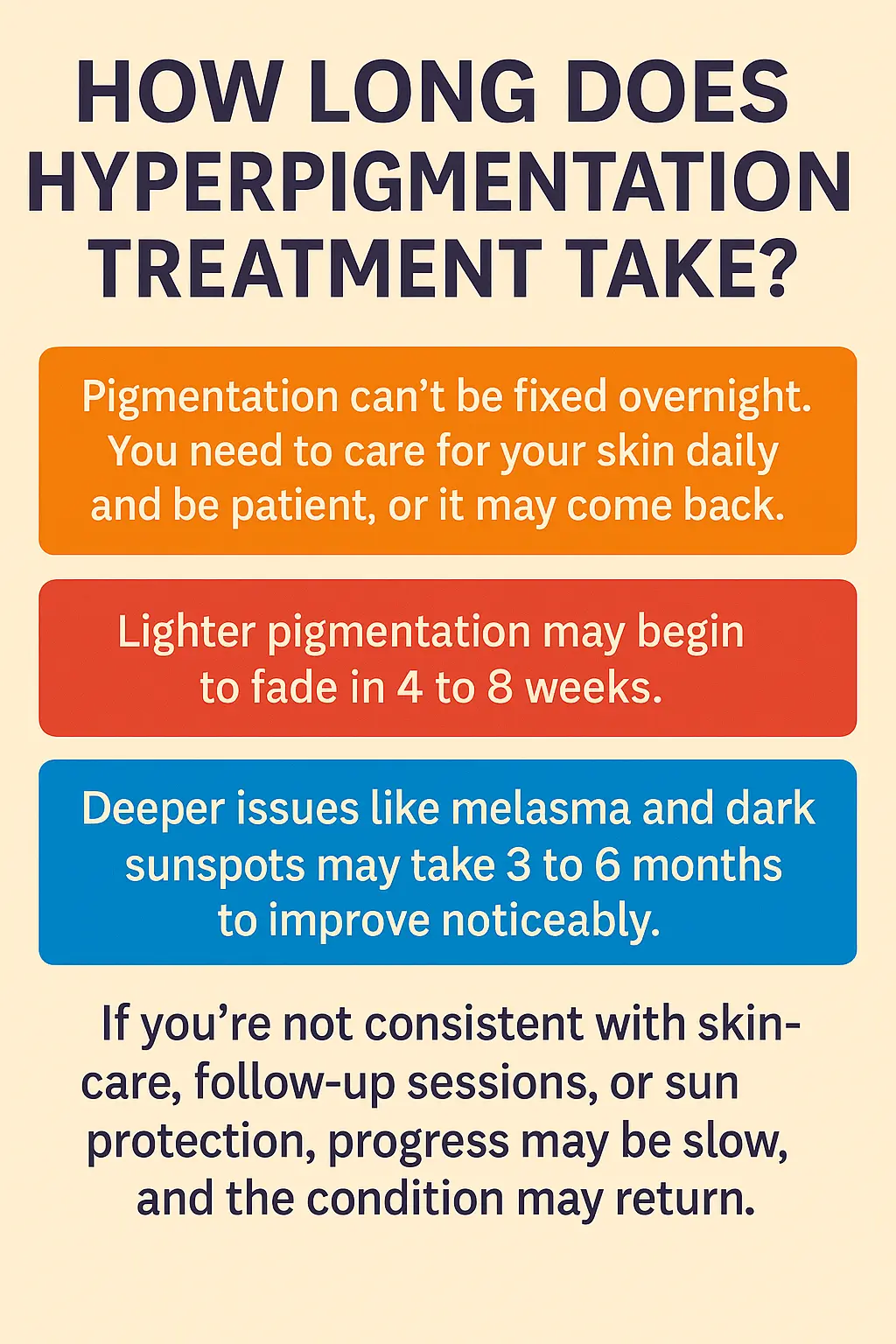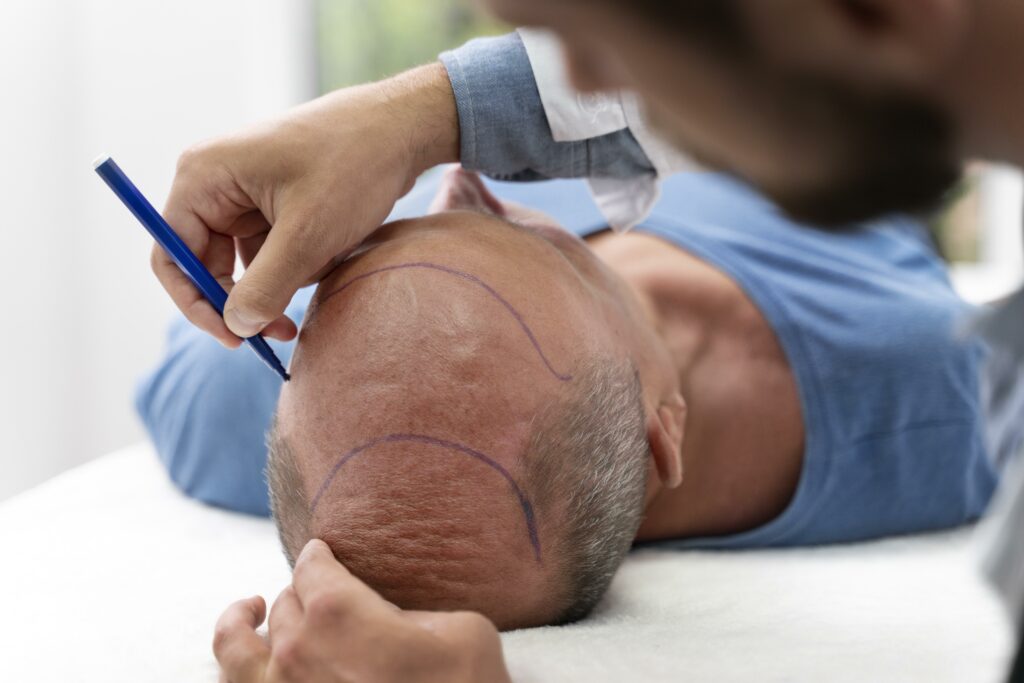Struggling with uneven patches or stubborn dark spots? The worry that these marks might stay permanently can be both frustrating and disheartening. The fear that they might never fade is real.You could be dealing with hyperpigmentation, a very common skin concern that affects people of all ages – skin tones, and types, often impacting your self-esteem. Fortunately, with modern hyperpigmentation treatment, you can achieve the clear, even-toned, and brighter skin you desire.
In this blog, we will delve into what causes hyperpigmentation, the types you might encounter, and most importantly, the most effective treatments to achieve clearer, brighter skin.
What Is In This Blog:
- What Is Hyperpigmentation?
- Different Types of Hyperpigmentation
- What Are the Main Causes of Hyperpigmentation?
- Types of Hyperpigmentation Treatments In Depth
- Aftercare Tips: What to Do After a Hyperpigmentation Treatment
- Emerging Trends in Hyperpigmentation Treatment
- How Long Do Hyperpigmentation Treatments Take?
- FAQs About Hyperpigmentation Treatment
- Final Thoughts: Your Clear Skin Journey Starts Here
What Is Hyperpigmentation?
Hyperpigmentation occurs whenever your skin areas start to become darker than usual due to an excessive amount of production of melanin – the pigment that gives our skin its colour.These lasting dark patches often stand out from your natural skin tone, whether due to excessive sun exposure, acne scars, hormonal changes, or other various reasons. For safe, effective, and long-term results, it’s always best to seek professional hyperpigmentation treatment rather than relying on unproven home remedies.
Different Types of Hyperpigmentation
Hyperpigmentation doesn’t always look the same and can be more stubborn in medium to deeper skin tones.Understanding the type of pigmentation you are dealing with can help guide the right treatment approach.
1. Melasma
People with brown, grey, or grey-brown patches on their skin, especially on the nose, chin, cheeks, or forehead, are likely to have melasma – one of the most challenging skin concerns to treat. It’s usually triggered by excessive sunlight exposure, hormonal changes in the body, and some other various reasons such as age factor. Melasma treatment often includes a combination of customised skincare, sunscreens, topical creams, chemical peels, and advanced light-based laser therapies.
Helpful Tip: Melasma can be very difficult to remove easily. However, we can prevent it from worsening by availing hyperpigmentation treatment from an aesthetic clinic and applying sunscreen every day.
2. Sunspots (Solar Lentigines)
When sensitive areas such as the face, arms, hands, or shoulders are exposed to sunlight for extended periods, they may suffer sun damage, forming small but noticeable dark sunspots.To treat this type of hyperpigmentation, laser-based sunspot removal treatments are preferred, such as IPL (Intense Pulsed Light), because they provide highly effective, better results.
Helpful Tip: If you want to prevent new sunspots or reduce their appearance, sunscreen is your best friend and defence. Always choose a broad-spectrum SPF and wear it every day, even when it’s cloudy or you’re indoors.
3. Post-Inflammatory Hyperpigmentation (PIH)
Post-inflammatory hyperpigmentation, appearing as black, purple, or brown patches, is quite common. It develops after injuries, cuts, acne, burns, or other skin traumas and flare-ups like eczema.The good news is that it tends to respond well to gentle treatment, especially with consistent care including chemical peels, serums like vitamin C, microneedling, and medical-grade solutions that help heal your skin.
Helpful Tip: Avoid picking at acne or scabs, as this can leave behind dark-brown scars. Always care for your skin by wearing sunscreen to protect your skin barrier and prevent PIH from worsening.
4. Freckles
Freckles appear as small, flat brown spots and can darken due to intense sun exposure. They are harmless but usually genetic. UV ray exposure can make them look darker than usual or even more widespread. Many people who prefer their skin to be lighter and brighter opt for freckle removal treatments, using chemical peels and laser therapy to help remove them.
Helpful Tip: If you love the freckles on your face, embrace them with pride! But if you wish for them to fade, avoid UV rays as much as possible and consider using brightening skincare serums or creams.
5. Age Spots (Liver Spots)
Age spots, sometimes called liver spots, are flat, dark patches that often develop on the face, hands, shoulders, and arms — the areas most exposed to sunlight. They are usually brown, black, or grey in color and become more common with age, especially after years of UV exposure. Although age spots are harmless and don’t require medical treatment, many people choose dark spot treatments to lighten them for a fresher, more youthful, and more even-toned complexion. Treatments like chemical peels, laser therapies such as IPL and PicoSure, and skincare brightening creams can effectively reduce their appearance over time.
Helpful Tip: Protect your skin daily by applying a broad-spectrum sunscreen while going out, even on cloudy days. This simple habit can help prevent new age spots from forming and stop existing ones from getting darker. If you’re looking to fade age spots, visit an aesthetic clinic for personalised treatment options that suit your skin type.
What Are the Main Causes of Hyperpigmentation?
You can seek treatment for dark spots – but first, you need to understand what really causes hyperpigmentation. Knowing the causes makes it easier to prevent them from worsening. Several factors can trigger this skin condition. Here are some of the most common ones:
Sunlight Exposure
Excessive sun exposure is the most common factor that increases melanin production, leading to sunspots on sensitive areas like the face, hands, arms, and shoulders.
Hormonal Changes
Uneven, dark patches on the face or other parts of the body—most commonly in women—can occur during pregnancy, while someone is using birth control pills, or when undergoing hormone-based treatments.
Skin Trauma or Inflammation
When the skin heals after trauma, such as eczema, acne, or injury, the dark marks stay on the skin – this is especially common in people with deeper skin tones.
Medications
Certain medications, especially chemotherapy drugs or some antibiotics, can disrupt melanin production, leading to noticeable pigmentation changes.
Genetic Factors
People with a genetic tendency – since hyperpigmentation can run in families – might be more prone to developing dark spots more easily than others.
Types of Hyperpigmentation Treatments In Depth
There is no single solution for all pigmentation concerns. Treatment depends on your skin type, the underlying causes, and how deep the pigmentation has penetrated.Here’s a breakdown of the most common methods, with realistic safety measures and practical solutions:
Melasma Treatment with Exosomes: A Safe and Advanced Solution
Nothing works better for Melasma Treatment than exosomes because they help the skin heal naturally and fade discoloration gradually. You might be thinking, what is Exosomes and How Can It Help in Treating Melasma – right?. Basically, Exosomes are tiny little particles that come from healthy cells, and they can send important messages to your skin to help it repair itself. Think of it like sending a text message to your skin, telling it what to do.
So, if someone has a condition like melasma, where dark spots appear on the skin and they are looking for melasma treatment with effective results, then exosome treatment can be very helpful. Because it is like giving your skin a superpower boost! The exosomes help the skin produce new, healthy cells, which can fade the dark spots and even out the skin tone.
Benefits of Exosome Treatment for Melasma:
- Faster Healing: Exosomes help your skin heal more quickly.
- Reduces Dark Spots: The treatment can help fade melasma and lighten dark spots.
- Improves Skin Tone: Exosomes help make your skin tone more even and smooth.
- Safe and Effective: It’s a safe treatment with good results for treating melasma.
Microneedling for Freckle Removal: Solution for Freckle-Free Skin
Looking for a treatment to fade unwanted freckles? Microneedling is a popular choice for freckle removal because it stimulates collagen and elastin production while allowing your skin to naturally absorb brightening serums during the healing process. Freckles are small, pigmented spots that often appear on the forehead, cheeks, nose, or chin – and when clustered, they can create a patchy, uneven appearance.
Microneedling is an effective solution for reducing patchy spots in targeted areas, as it enhances the skin’s natural ability to renew. This treatment uses ultra-fine needles to create micro-injuries in the skin, allowing skincare products to penetrate more deeply and work more effectively – especially while treating hyperpigmentation.
Why is Microneedling a great option for Freckle Removal?
- Enhances the penetration of brightening serums like vitamin C
- Breaks down excess melanin clusters
- Improves skin smoothness and texture
- Gradually reduces dark patches with consistent treatment sessions
If you are looking for a more natural, gradual approach to freckle removal and overall skin rejuvenation, microneedling stands out as a safe and effective choice.
Chemical Face Peel – A Proven, Safest Solution
A chemical face peel is considered one of the most trusted and effective solutions for treating mild pigmentation. During the procedure, a skilled aesthetician applies a specially formulated solution designed to target hyperpigmentation and reduce dark spots. This gentle peel exfoliates the skin’s surface (removes dead skin cells), promotes new cell growth, and encourages the regeneration of a fresher, more radiant complexion.
Ideal for:
- Mild sunspots
- Acne scars
- Mild Surface Pigmentation
Steps in a Chemical Face Peel Process:
- The aesthetician begins by cleansing your skin to remove dirt, oil, and debris.
- A peeling solution – such as glycolic acid, salicylic acid, or TCA – is then carefully applied.
- After application, you may experience a tingling or warming sensation for a few minutes; this is
completely normal and is part of the treatment. - The peel is then neutralised, and the skin is moisturised with soothing aftercare products.
Chemical peels vary in strength:
- Light peels: Ideal for surface-level pigmentation and require minimal recovery time.
- Medium peels: Penetrate deeper and are effective for treating sunspots and mild
melasma. - Deep peels: Target severe pigmentation but involve a longer recovery period.
Benefits of chemical peels:
- Reduces hyperpigmentation to help even out skin tone
- Improves skin texture and brightness
- Boosts collagen production for healthier, firmer skin
Although chemical peels offer many benefits, there are also potential risks. If performed by an inexperienced provider, the treatment can lead to unwanted outcomes such as an increase in hyperpigmentation (darkening of the skin) or hypopigmentation (lightening of the skin). These side effects are more common in individuals with brown or black skin and, in some cases, these side effects may be permanent.
That’s why it’s essential to consult a consultant in a good aesthetic clinic before undergoing a chemical face peel.
Laser therapy for Sunspot Removal
Laser therapy is an effective treatment option for people with sunspots. In this overview, we’ll focus on the two laser types that are most effective for sunspot removal.
Q-Switched Laser
The Q-Switched Laser is a leading treatment for sunspot removal and for treating deep pigmentation issues like age spots, freckles, and melasma. It uses rapid and high-intensity pulses to break down excess melanin, which the body naturally clears over time. This laser precisely targets dark spots without harming surrounding skin, offering minimal downtime and a lower risk of scarring.
It is safe for a wide range of skin types, including medium to dark tones, when performed by a trained professional. With treatment sessions spaced every 3-4 weeks, patients typically see fewer dark spots, clearer skin, and a more even complexion. Results improve gradually, making this treatment a reliable and effective solution for long-term hyperpigmentation.
Fractional Laser
Fractional laser treatment is an effective and reliable solution for achieving a clearer complexion, especially after severe sun damage that leads to sunspots.
It’s also beneficial for treating acne scars and improving dull or uneven skin texture. This advanced laser works by creating tiny, controlled micro-injuries in the skin, which stimulate collagen production and support the skin’s natural renewal process—enhancing overall skin quality over time.
Best Treatments for Age Spot Removal
When your skin is in the sun a lot for many years, flat, dark spots called age spots can appear on your face. They are not harmful, but many people choose to remove them to make their skin look fresher, younger, and brighter.
Age Spot Removal: Best Treatments
IPL Therapy
Intense Pulsed Light (IPL) therapy is different from lasers. It uses special light to find and break up dark spots in the skin. This helps the spots fade slowly and makes the skin look clearer over time.
How IPL Works:
- The pigment in your skin absorbs the light energy.
- Heat from the light breaks down the excess pigment.
- This process encourages the skin to heal and appear more even-toned.
- It is highly effective for removing sunspots, treating melasma, and fading freckles – all without
requiring much downtime. - The dark color in your skin takes in the light.
- The heat from the light helps break up the dark spots.
- This helps your skin heal and look more even.
- It works well for removing sunspots, lightening melasma, and fading freckles — and you don’t need a long
time to rest after treatment.
PicoSure Laser
PicoSure is widely regarded as one of the most effective and powerful treatments for pigmentation. It uses ultra-fast pulses to break pigment particles into tiny fragments, which are then naturally cleared by the body. The treatment works quickly and delivers noticeable, long-lasting results in a short period of time.
Benefits of using Laser Therapies
- Delivers quick results with minimal discomfort
- Precisely targets the affected areas for safer treatment
- Low risk of damage to the surrounding skin
Both treatments for age spot removal work effectively to reduce dark patches and help restore an even-toned complexion—boosting your confidence in the process. They can also be used to treat freckles and sunspots with excellent results.
Topical solutions for Dark spot Treatment
Topical solutions can help reduce mild pigmentation, mainly when used regularly. They are highly effective and often considered the first choice for targeting small patches and dark spot treatment. These treatments are easy to apply and encourage consistency, as they typically show gradual improvement within a short period.
People with sensitive skin often prefer topical treatments because they help minimise irritation. Topical solutions include ointments, serums, and creams. Ingredients like vitamin C, niacinamide, and kojic acid are commonly used in these formulations to reduce melanin production and brighten the skin, helping to even out discoloration.
Ideal for:
- Sensitive skin
- Smaller, patches of dark spots
Key Ingredients:
- Vitamin C: Helps prevent melanin production and brightens skin tone
- Niacinamide: Strengthens the skin barrier and evens out pigmentation
- Kojic Acid: A natural skin-lightening agent derived from mushrooms
- Hydroquinone: A powerful bleaching agent that should be used under medical supervision
Table about Hyperpigmentation Types, Causes, treatment options, prevention tips, & Typical age range
| Types | Causes | Appearance | Treatment Options | Prevention Tips | Typical Age Range |
|---|---|---|---|---|---|
| Melasma | Hormonal changes, birth control pills, pregnancy | Dark patches on the face, usually symmetrical | Chemical peels, laser therapy, topical treatments like hydroquinone and retinoids | Avoid sun exposure, use SPF, avoid hormonal triggers | 20-40 years old, often during pregnancy |
| Freckles | Genetics, sun exposure | Small, light brown spots on the skin, often on the face | Laser treatments, bleaching creams, sun protection | Regular use of SPF, avoid sun exposure, avoid genetic triggers | Varies; commonly seen in children and adolescents |
| PIH | Skin inflammation, acne, or injury | Red or brown marks after acne or | Topical treatments (hydroquinone, vitamin C, retinoids), laser treatments | Avoid picking or scratching skin; use SPF and topical treatments | Teenagers to adults, typically after acne or injury |
| Sunspots | Excessive sun exposure | Flat, brown or black spots, often on face, hands, or shoulders | Laser treatments (IPL, PicoSure), topical creams with hydroquinone, chemical peels | Daily SPF, avoid prolonged sun exposure, wear hats or protective clothing | 30-50 years old |
| Age Spots | Excessive sunlight, ageing | Flat, dark spots on face, shoulders, or hands | Laser treatments, topical treatments (hydroquinone, retinoids), sun protection | Daily SPF, avoid prolonged sun exposure, wear hats or protective clothing | 30-50 years old |
Aftercare Tips: What to Do After a Hyperpigmentation Treatment
Even the most effective treatments require proper aftercare to ensure long-lasting results. Here are some key steps to follow after your session:
- Use SPF every day: Always wear sunscreen with SPF 30 or higher. After getting skin
treatment, your skin barrier becomes more sensitive to sun rays. Therefore, avoiding sunlight is a must. - Avoid strong products and scrubs: Give your skin time to rest after a peel, laser
session, or dark spot treatment. For a few days, avoid using retinol, exfoliating scrubs, or acidic
products. Instead, opt for gentle and soothing cleansers to support healing. - Keep your skin moisturised: Show your skin some love by applying antioxidants and
moisturiser daily. This helps maintain hydration and supports faster healing. - Don’t pick or peel your skin: Avoid touching or scratching the treated areas. Allow the
skin to shed and heal naturally. Picking can delay the healing process and may worsen pigmentation.
Sticking to your skincare routine as instructed is the best way to achieve and maintain long-lasting results.
Emerging Trends in Hyperpigmentation Treatment
The world of skin aesthetics is constantly evolving, with exciting innovations reshaping how we treat pigmentation. One emerging trend is AI-powered skin analysis, which delivers precise, personalised treatment plans tailored to your skin’s unique needs. Picosecond laser technology, such as PicoSure, is gaining popularity for its speed, safety, and minimal downtime – making it an ideal option for treating deeper pigmentation concerns.
Clinics are also seeing growing demand for custom-blended skincare serums, formulated with active ingredients like tranexamic acid and liquorice extract to target specific pigmentation concerns. These cutting-edge advances offer clients faster, more personalised results than ever before.
How Long Do Hyperpigmentation Treatments Take?
- Pigmentation can’t be fixed overnight. Daily skincare, consistency, and patience are essential —
otherwise, it may return. - Lighter pigmentation may begin to fade within 4 to 8 weeks.
- Deeper concerns like melasma or dark sunspots may take 3 to 6 months for noticeable improvement.
- If you’re not consistent with your skincare routine, follow-up treatments, or sun protection, progress
may slow — and the pigmentation may come back.
FAQs About Hyperpigmentation Treatment
Q1. How many sessions will I need?
It depends on the depth and severity of your pigmentation. Most people require between 3 and 6 sessions to achieve the best results.
Q2. Can hyperpigmentation come back?
It might come back if you don’t follow after-care advice or avoid sun exposure. New pigmentation can also develop if we are not careful.
Q3. Is there downtime after treatments?
Mild treatments, such as light chemical peels or IPL, require little to no recovery time — you can usually return to your normal routine the same day or the next. Stronger treatments, like deep peels or lasers, may require 5 to 7 days for the skin to heal.
Q4. Do treatments hurt?
Most mild treatments cause a warm or tingling sensation. They aren’t painful, but you may feel a bit of discomfort for a short time.
Q5. Are treatments safe for darker skin tones?
Yes! Treatments such as microneedling, gentle chemical peels, and low-energy lasers are safe and effective for darker skin. These methods are often customised to suit deeper skin tones.
Q6. Can I treat pigmentation at home?
Yes, you can start with products containing vitamin C, niacinamide, and other antioxidants. However, professional treatments from certified aesthetic clinics are safer and more effective for deeper pigmentation and to achieve faster results.
Final Thoughts: Your Clear Skin Journey Starts Here
Hyperpigmentation is very common, and there’s no reason to feel embarrassed about it. Whether you’re dealing with acne scars, dark patches, or seeking melasma treatment, there is hope. Safe and effective treatments are available to help you feel more confident in your skin.
Professional treatments like chemical peels, laser therapies, and microneedling offer some of the most effective and long-lasting results for pigmentation, including freckles. The key to achieving clear, glowing skin is choosing the right treatment, working with qualified experts, and following a consistent skincare routine — including daily sunscreen use.
Feeling unsure about how to get started or how to get age spots removed? You’re not alone – reach out to trusted aesthetic clinics like Shumaila’s London for personalised solutions that treat pigmentation, brighten your skin, and help you feel confident again.
Start your Hyperpigmentation treatment today and reveal the radiant, even-toned skin you deserve!
Ready to Transform Your Skin?
Book your FREE consultation today and discover the best hyperpigmentation treatments for your unique skin.
